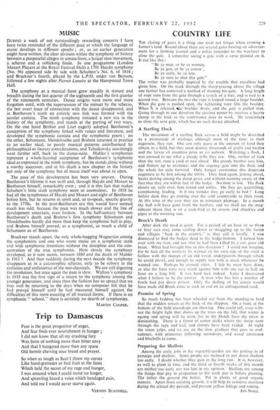MUSIC
DURING a week of not outstandingly rewarding concerts I have been twice reminded of the different pace at which the language of music develops in different epochs ; or, as an earlier generation might have written, the clear division within the symphony of history between .a purposeful allegro in sonata form, a lyrical slow movement, a scherzo and a rollicking finale. In one programme (London Mozart Players at the Royal Festival Hall) a 1791 Haydn symphony (No. 96) appeared side by side with Schubert's No. 6, of 1818 ; and Bruckner's fourth, played by the L.P.O. under van Beinum, followed a few nights after Pierrot Lunaire at the Hampstead Town Hall.
The symphony as a musical form grew steadily in stature and breadth during the last quarter of the eighteenth and the first quarter of the nineteenth centuries. Dance origins were more and more forgotten until, with the supersession of the minuet by the scherzo, the last overt trace of connection with the dance disappeared, and in Beethoven's ninth an entirely new link was formed with the secular cantata. The ninth symphony initiated a new era in the history of the symphony, and stands at the parting of two ways. On the one hand Berlioz and Liszt eagerly adopted Beethoven's conception of the symphony linked with voices and literature, and developed the symphonic cantata and the symphonic poem ; on the other, Schumann, Mendelssohn and Brahms returned in practice to an earlier ideal, to purely musical patterns uninfluenced by philosophical or literary considerations, and Tchaikovsky unwittingly went further still, back to the dance-suite. Mahler's symphonies represent a whole-hearted acceptance of Beethoven's symphonic ideal as expressed in the ninth symphony, but he stands alone without a worthy successor, and at his death a new chapter in the history not only of the symphony but of music itself was about to open.
The pace of this development has been very uneven. During Beethoven's lifetime it was swift and, through Haydn and Mozart to Beethoven himself, remarkably even ; and it is this fact that makes Schubert's little sixth symphony seem so anomalous. In 1818 he had all the symphonies of Haydn and Mozart and eight of Beethoven before him, but he returns in spirit and, so to-speak, specific gravity to the 1770s. In the post-Beethoven era this would have seemed much less odd, because the pace was much slower and the line of development uncertain, even broken. In the half-century between Beethoven's death and Brahms's first symphony Schumann and Mendelssohn hardly did more than keep the symphonic ball in play, and Brahms himself proved, as a symphonist, as much a child of Schumann as of Beethoven.
Bruckner stands apart, the only whole-hogging Wagnerian among the symphonists and one who wrote music on a symphonic scale and with symphonic -intentions without the discipline and the con- centration of the true symphonist. How slowly the symphony developed, as it now seems, between 1880 and the death of Mahler in 1911 ! And then suddenly during the next decade the symphony disappears as in a catastrophic scherzo, only to be reborn in the sinfonias and sinfoniettas of the neo-classicals. We are still digesting the revolution, but once again the pace is slow." Walton's symphony • in 1935 was the first sign of a return to the symphony among the younger generation, and since then the fashion has so spread that we may well be returning to the days when no composer felt that he had proved himself until he had measured himself against the difficulties of this most exacting of all musical forms. If there is no symphonic " school," there is certainly no dearth of symphonies.
MARTIN COOPER.


































 Previous page
Previous page